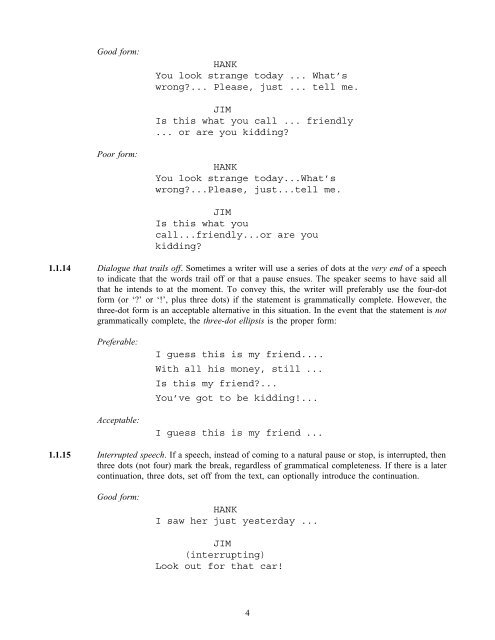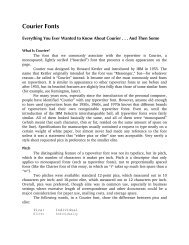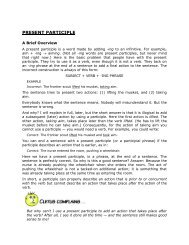Ellipsis - Roland Stroud
Ellipsis - Roland Stroud
Ellipsis - Roland Stroud
You also want an ePaper? Increase the reach of your titles
YUMPU automatically turns print PDFs into web optimized ePapers that Google loves.
Good form:<br />
HANK<br />
You look strange today ... What’s<br />
wrong?... Please, just ... tell me.<br />
JIM<br />
Is this what you call ... friendly<br />
... or are you kidding?<br />
Poor form:<br />
HANK<br />
You look strange today...What’s<br />
wrong?...Please, just...tell me.<br />
JIM<br />
Is this what you<br />
call...friendly...or are you<br />
kidding?<br />
1.1.14 Dialogue that trails off. Sometimes a writer will use a series of dots at the very end of a speech<br />
to indicate that the words trail off or that a pause ensues. The speaker seems to have said all<br />
that he intends to at the moment. To convey this, the writer will preferably use the four-dot<br />
form (or ‘?’ or ‘!’, plus three dots) if the statement is grammatically complete. However, the<br />
three-dot form is an acceptable alternative in this situation. In the event that the statement is not<br />
grammatically complete, the three-dot ellipsis is the proper form:<br />
Preferable:<br />
Acceptable:<br />
I guess this is my friend....<br />
With all his money, still ...<br />
Is this my friend?...<br />
You’ve got to be kidding!...<br />
I guess this is my friend ...<br />
1.1.15 Interrupted speech. If a speech, instead of coming to a natural pause or stop, is interrupted, then<br />
three dots (not four) mark the break, regardless of grammatical completeness. If there is a later<br />
continuation, three dots, set off from the text, can optionally introduce the continuation.<br />
Good form:<br />
HANK<br />
I saw her just yesterday ...<br />
JIM<br />
(interrupting)<br />
Look out for that car!<br />
4




